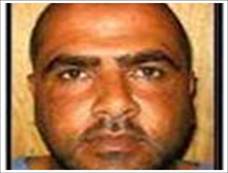|
|
|
Al Qaeda in Iraq leader Hajji Hammadi, killed by US forces on Nov. 11, 2008. |
US forces killed another senior al Qaeda in Iraq leader during counterterrorism raids in Iraq. Hajji Hammadi, an al Qaeda leader in eastern Anbar province, is the fourth senior al Qaeda leader killed in Iraq and neighboring Syria over the past six weeks.
Hammadi was killed by the hunter-killer teams of Task Force 88 on Nov. 11. The special operations forces killed Hammadi and an associate after a firefight broke out during an operation to capture him in Baghdad’s Mansour neighborhood.
Hammadi, who was also known as Hammadi Awdah Abd Farhan and Abd al Salam Ahmad Abdallah al Janabi, was an Iraqi who was involved with al Qaeda in Iraq since its formation. He had “connections with the country’s legacy al Qaeda leadership,” including Abu Musab al Zarqawi and Abu Ayyub al Masri, according to Multinational Forces Iraq.
Zarqawi appointed Hammadi the emir, or leader, of Karmah in eastern Anbar province and Abu Ghraib, an al Qaeda haven just west of Baghdad. Hammadi led an al Qaeda unit during the second battle of Fallujah, where more than 2,000 al Qaeda in Iraq and allied insurgents were killed during the US effort to clear the city.
He was detained in 2006, escaped from prison in 2007, and then resumed his duty as the emir of Karmah and Abu Ghraib, Multinational Forces Iraq told The Long War Journal in an email inquiry.
As an emir in eastern Anbar, Hammadi was “responsible for planning and conducting multiple attacks on Coalition forces, Iraqi Police, Iraqi government officials and Iraqi citizens,” the US military stated. “These attacks were carried out as suicide and car bombings, kidnappings, executions and assassinations.”
His most recent high profile attack was the June 26, 2008 suicide strike at a tribal meeting in Karmah. Twenty Iraqis, including the town mayor and several sheikhs, and three US Marines, including Lieutenant Colonel Max Galeai, the commander of the 2nd Battalion, 3rd Marines were killed in the deadly attack. An al Qaeda operative disguised himself as a policeman and penetrated security for the event.
Hammadi has also been behind the assassinations of several leaders and members of the Sons of Iraq, the local tribal fighters that organized to oppose al Qaeda in Iraq, as well as the kidnapping and murder of US Army Staff Sergeant Matt Maupin in 2004.
The Karmah region was one of the last areas in Anbar province that was tamed by US and Iraqi forces in conjunction with the Anbar Awakening. Karmah and Abu Ghraib were part of al Qaeda’s western Baghdad “belt,” one of four regions surrounding the capital. Al Qaeda used these belts to control access to Baghdad and funnel money, weapons, car bombs, and fighters into the city. Al Qaeda also attempted to strangle the US helicopter air lanes to western Anbar by emplacing anti-aircraft cells along known routes.
Taking down al Qaeda’s leadership team in Iraq
Hammadi is the fourth senior al Qaeda in Iraq leader killed since Oct. 5. The targeting of al Qaeda’s senior leadership has further degraded the terror group’s ability to conduct successful, high profile attacks, the US military said.
US special operations forces killed Abu Qaswarah al Skani (the Swede), al Qaeda’s second in command, during a raid in Mosul. Qaswarah, whose real name is Mohamed Moumou, was born in Morocco and held citizenship in Sweden. Originally a member of Ansar al Sunnah, he trained in al Qaeda camps in Pakistan and Afghanistan in the 1990s and had close connections with Zarqawi. He commanded al Qaeda forces in northern Iraq before being appointed al Qaeda in Iraq’s second in command.
The second major kill by US forces took place outside of Iraq’s borders, in eastern Syria, on Oct. 27. Task Force 88 conducted a daring daylight raid in an attempt to capture Abu Ghadiya, al Qaeda senior facilitator and logistics coordinator for foreign fighters entering Iraq. He, along with several members of his staff, were killed in the ensuing firefight. Ghadiya, whose real name is Badran Turki Hishan Al Mazidih, was an Iraqi from the northern city of Mosul. Zarqawi appointed Ghadiya as al Qaeda’s senior facilitator in Syria in 2005. After Zarqawi’s death, he took orders directly from Abu Ayyub al Masri, al Qaeda’s current leader.
Iraqi soldiers and the Sons of Iraq scored the third major kill during an operation in Tarmiyah on Nov. 7. Abu Ghazwan, whose real name is Saad Ismael Abdul Salah al Hiyali, was a senior al Qaeda leader in the regions north of Baghdad in Salahadin and northern Baghdad province. He was a direct associate of al Qaeda in Iraq leader Abu Ayyub al Masri. In 2006 and 2007, Ghazwan led al Qaeda’s efforts to take control of Baghdad. He commanded the northern Baghdad belt region.









4 Comments
Bill,
Do you know if he was affiliated with the former regime of Saddam?
The Thunder Run has linked to this post in the blog post From the Front: 11/21/2008 News and Personal dispatches from the front and the home front.
Just returned from Iraq and this area was our AO. This couldn’t have happen to a nicer guy:) There’s a few more of his cronies that need to meet the same fate.
Outstanding job TF 88.I hope the bad guys are getting the picture.Our Special Ops can reach out and tickle you where you sleep.Thank you.God Bless